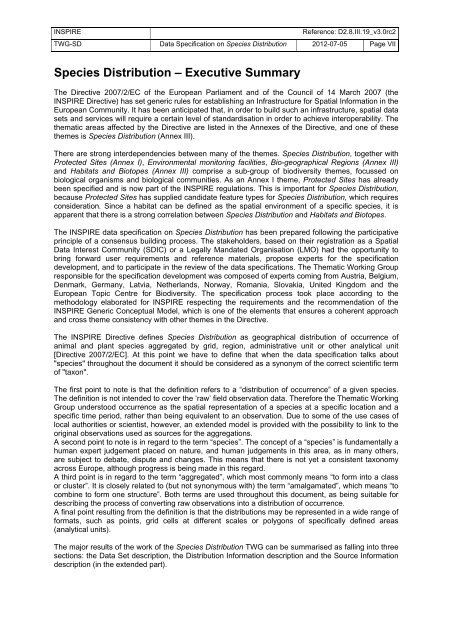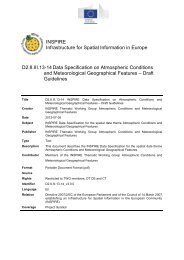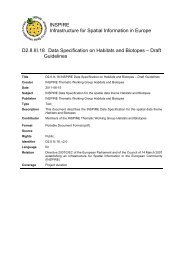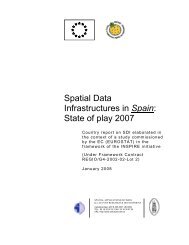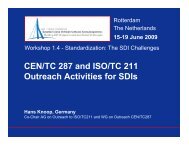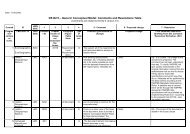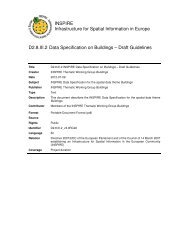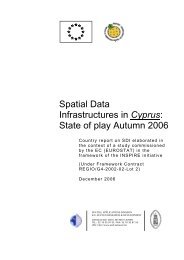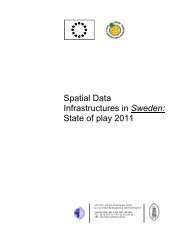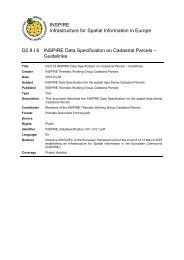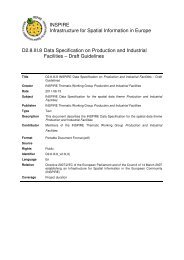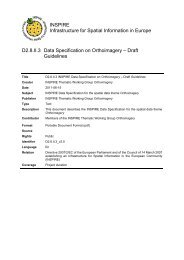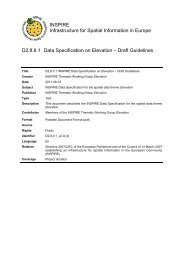Download Version 3.0 rc2 - Inspire - Europa
Download Version 3.0 rc2 - Inspire - Europa
Download Version 3.0 rc2 - Inspire - Europa
You also want an ePaper? Increase the reach of your titles
YUMPU automatically turns print PDFs into web optimized ePapers that Google loves.
INSPIRE Reference: D2.8.III.19_v<strong>3.0</strong><strong>rc2</strong><br />
TWG-SD Data Specification on Species Distribution 2012-07-05 Page VII<br />
Species Distribution – Executive Summary<br />
The Directive 2007/2/EC of the European Parliament and of the Council of 14 March 2007 (the<br />
INSPIRE Directive) has set generic rules for establishing an Infrastructure for Spatial Information in the<br />
European Community. It has been anticipated that, in order to build such an infrastructure, spatial data<br />
sets and services will require a certain level of standardisation in order to achieve interoperability. The<br />
thematic areas affected by the Directive are listed in the Annexes of the Directive, and one of these<br />
themes is Species Distribution (Annex III).<br />
There are strong interdependencies between many of the themes. Species Distribution, together with<br />
Protected Sites (Annex I), Environmental monitoring facilities, Bio-geographical Regions (Annex III)<br />
and Habitats and Biotopes (Annex III) comprise a sub-group of biodiversity themes, focussed on<br />
biological organisms and biological communities. As an Annex I theme, Protected Sites has already<br />
been specified and is now part of the INSPIRE regulations. This is important for Species Distribution,<br />
because Protected Sites has supplied candidate feature types for Species Distribution, which requires<br />
consideration. Since a habitat can be defined as the spatial environment of a specific species, it is<br />
apparent that there is a strong correlation between Species Distribution and Habitats and Biotopes.<br />
The INSPIRE data specification on Species Distribution has been prepared following the participative<br />
principle of a consensus building process. The stakeholders, based on their registration as a Spatial<br />
Data Interest Community (SDIC) or a Legally Mandated Organisation (LMO) had the opportunity to<br />
bring forward user requirements and reference materials, propose experts for the specification<br />
development, and to participate in the review of the data specifications. The Thematic Working Group<br />
responsible for the specification development was composed of experts coming from Austria, Belgium,<br />
Denmark, Germany, Latvia, Netherlands, Norway, Romania, Slovakia, United Kingdom and the<br />
European Topic Centre for Biodiversity. The specification process took place according to the<br />
methodology elaborated for INSPIRE respecting the requirements and the recommendation of the<br />
INSPIRE Generic Conceptual Model, which is one of the elements that ensures a coherent approach<br />
and cross theme consistency with other themes in the Directive.<br />
The INSPIRE Directive defines Species Distribution as geographical distribution of occurrence of<br />
animal and plant species aggregated by grid, region, administrative unit or other analytical unit<br />
[Directive 2007/2/EC]. At this point we have to define that when the data specification talks about<br />
"species" throughout the document it should be considered as a synonym of the correct scientific term<br />
of "taxon".<br />
The first point to note is that the definition refers to a “distribution of occurrence” of a given species.<br />
The definition is not intended to cover the ‘raw’ field observation data. Therefore the Thematic Working<br />
Group understood occurrence as the spatial representation of a species at a specific location and a<br />
specific time period, rather than being equivalent to an observation. Due to some of the use cases of<br />
local authorities or scientist, however, an extended model is provided with the possibility to link to the<br />
original observations used as sources for the aggregations.<br />
A second point to note is in regard to the term “species”. The concept of a “species” is fundamentally a<br />
human expert judgement placed on nature, and human judgements in this area, as in many others,<br />
are subject to debate, dispute and changes. This means that there is not yet a consistent taxonomy<br />
across Europe, although progress is being made in this regard.<br />
A third point is in regard to the term “aggregated”, which most commonly means “to form into a class<br />
or cluster”. It is closely related to (but not synonymous with) the term “amalgamated”, which means “to<br />
combine to form one structure”. Both terms are used throughout this document, as being suitable for<br />
describing the process of converting raw observations into a distribution of occurrence.<br />
A final point resulting from the definition is that the distributions may be represented in a wide range of<br />
formats, such as points, grid cells at different scales or polygons of specifically defined areas<br />
(analytical units).<br />
The major results of the work of the Species Distribution TWG can be summarised as falling into three<br />
sections: the Data Set description, the Distribution Information description and the Source Information<br />
description (in the extended part).


